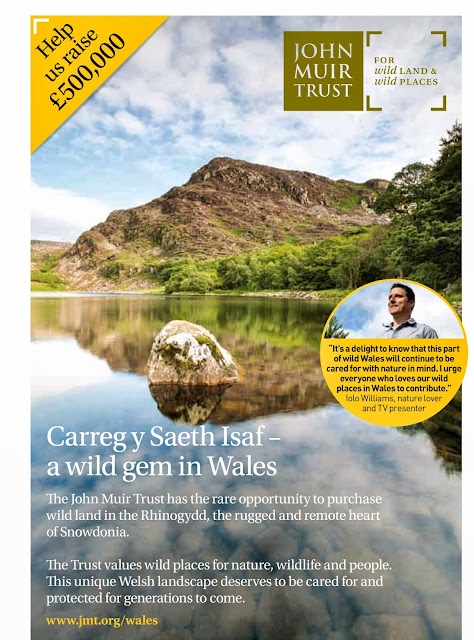TV presenter and wildlife champion Iolo Williams has given his backing to a wild land charitys bid to buy a key conservation site in the Snowdonia National Park.
The John Muir Trust, which owns and manages a number of mountain landscapes in Scotland, including Ben Nevis, has launched a 500,000 appeal to buy the Carreg y Saeth Isaf estate in the Rhinogydd Mountains.
Iolo Williams welcomed the move saying: Its a delight to know that this part of wild Wales will continue to be cared for with nature in mind. I urge everyone who loves our wild places to contribute to the fundraising appeal.
The Trust is a membership organisation, named after the founder of the modern conservation movement, Scots-American John Muir. It has been active in Wales since 2001, working with 100 partners including schools, colleges, clubs, conservation and outdoor organisations to deliver the John Muir Award scheme to 33,000 people.The Trust has also campaigned in Wales to protect wild landscapes from industrial development.
Although of modest size, Carreg y Saeth Isaf is an important ecological site. Located near the village of Llanbedr in Gwynedd, the parcel of land is within a Site of Special Scientific Interest and the wider area is recognised as a Special Area of Conservation and a Biogenetic Reserve.
It consists of rocky upland, sessile oak woodland and an area of heath and bog, which is home to merlin, peregrine, hen harrier, black grouse and ring ouzel. The native woodlands harbour a great diversity of birdlife such as redstarts and pied flycatcher.
The current landowner has expressed a wish for the Trust to buy the land, to continue his light-touch management approach and encourage natural processes to take their course.
Stuart Brooks chief executive of the John Muir Trust said: Carreg y Saeth Isaf would be our first land purchase outside Scotland. It is a beautiful wild gem in the Rhinogydd, the rugged heart of Wales, and is just the sort of wild place that the John Muir Trust exists to care for. Were delighted to have the opportunity to continue managing it for the benefit of people and wildlife.
The Trust hopes to work with others in the area, including the Snowdonia National Park, Natural Resources Wales, the Campaign for the Protection of Rural Wales, the Snowdonia Society, the Woodland Trust, National Trust Wales and the North Wales Wildlife Trust, as well as local communities and private landowners.
About the Carreg y Saeth fundraising appeal
Following an approach from the current owner of an estate in the Rhinogydd Mountains, within the Snowdonia National Park, the John Muir Trust has launched a 500,000 financial appeal to cover the cost of the purchase of the land plus ongoing running costs.
We have produced an appeal leaflet and have more in-depth information on our website at www.jmt.org/wales.asp .
About the John Muir Trust
The John Muir Trust is the leading wild land conservation charity in the UK. More than 10,000 members support us in our work. Find out more at www.jmt.org .
We take our name and inspiration from John Muir (1838-1914), the pioneering, influential Scots-born American conservationist who was passionate about the wild. Muir dedicated his life to protecting wild places and he campaigned successfully for the establishment of National Parks to safeguard vast tracts of wild lands, including Yosemite Valley in California.
We are based in the town of Pitlochry in Highland Perthshire, where we run the Wild Space visitor centre.
We own and manage some of the finest wild areas in the UK including Ben Nevis and Glen Nevis; Schiehallion in Perthshire; Sandwood Bay in Sutherland; part of the Cuillin in Skye; Quinag in Assynt; part of the Knoydart peninsula; and Glenlude in the Scottish Borders.
We also work in partnership with a range of community owned estates, including North Harris Trust, West Harris Trust, Galson Trust (Lewis), Knoydart Foundation, Assynt Foundation, Nevis Partnership and Carrifran Woodland ; plus two private estates Corrour (Lochaber) and Kynachan (Perthshire).
We for greater protection for wild land across the UK from industrial-style developments, including from large-scale wind farms.
We manage our properties according to our wild land management standards, which focus on habitat improvement and encouraging a more natural landscape and ecosystem.
Through the John Muir Award, we encourage people of all ages and backgrounds to connect with, enjoy and care for wild places. Since 1997, more than 100,000 people across the UK have achieved an Award. Read more about this educational initiative at www.johnmuiraward.org





